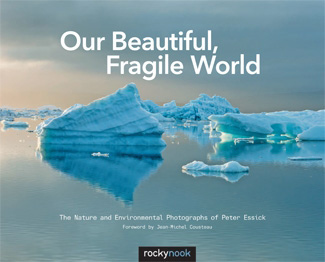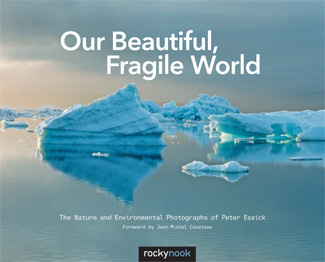 (Image: Rocky Nook)I have read dozens of books dealing with the natural world and the environmental crisis, but rarely have I come across the mirror of the world I discovered in the pages of Our Beautiful, Fragile World (Rocky Nook, 2013).
(Image: Rocky Nook)I have read dozens of books dealing with the natural world and the environmental crisis, but rarely have I come across the mirror of the world I discovered in the pages of Our Beautiful, Fragile World (Rocky Nook, 2013).
I looked at this global mirror, and I did not like the image. The world is upside down: Beautiful rivers are now dammed, their clean drinking water caught behind cement walls and their fish and wildlife dispersed or wiped out.
Not satisfied by this act of ecocide, timber companies have been logging forests, triggering the destruction of biodiversity and massive species extinction.
Then groups of “industrialized” humans moved from chemistry to chemical engineering and businesses manufacturing thousands of toxic chemicals, most of which are used without any testing or regulatory oversight.
The same carelessness characterizes the development of industrialized agriculture. Instead of small democratic family farmers and peasants raising our food – as they had done for millennia – giant agribusiness conglomerates “produce” most food. This industrial-scale food is impoverished in nutrition and contaminated by toxins. Second, agribusiness wastes are deleterious and significant. They account for 18 percent to 51 percent of the total greenhouse gases warming the planet. Fertilizers and pesticides pollute our drinking water, rivers and seas; indeed, they create huge dead zones in the seas.
In addition, “powerful” countries show off their power with nuclear weapons and nuclear power plants. But manufacturing these weapons and operating these factories generate thousands of tons of deleterious wastes that remain toxic to life for millions of years.
This dreadful picture emerges in the carefully researched and documented Our Beautiful, Fragile World. The author, Peter Essick, is no radical academic or right- or left-wing journalist with an axe to grind. He is a nature photographer and photojournalist who worked for most of his life for the National Geographic, by no means a magazine of extreme views. If anything, National Geographic mirrors American business as usual.
Our Beautiful, Fragile World is a coffee-table book. But this is a coffee-table book with a difference. Most of its beautiful pictures zero-in on a human crime against nature. In the page facing each picture, Essick explains why he took the picture. Each photograph captures the essence and beauty of nature as well as state and business criminality and madness.
The Earth is large and humans tiny. Indeed, tiny humans worshipped the Earth for millennia. Plato thought of the Earth as the oldest of the gods. In his cosmological dialogue “Timaios,” the Earth is a giant sphere at the center of the universe. But the Earth is also beautiful, alive and teeming with life.
Christianity blurred this Platonic icon of an alive, immortal and sacred Earth. But the near-fatal blow against the Earth came from the puny humans who decided to mechanize everything. This period of “industrialization” started in the late 19th century and continues to this day. Our Beautiful, Fragile World sums up the deadly effects of this human mania with machines and “resources.” Humans turn out to be the most destructive and suicidal animals who ever walked on Earth. Their corporations are fighting a permanent war against our Mother Earth.
In a quiet and crisp style, Our Beautiful, Fragile World spotlights the tragic story of our world, illustrating what people have been doing to the natural world. Essick uses the attraction of his great pictures to bring out the brutality and toxic nature of industrial civilization.
Essick doubts we have the courage and wisdom to save ourselves by leaving petroleum and coal and natural gas where they are, for instance. The executives of these industries put their profits above civilization. They see no reason to stop production of the very stuff fueling the warming of the Earth. And the world’s governments remain either passive or voice the spin of the industry. In the United States, for example, President Barack Obama is about to approve the Canadian tar sands oil pipeline. Essick rightly equates the Canadian oil sands to money justifying anything.
Global warming, meanwhile, already is having its effects: Adelie penguins in Antarctica find it difficult to reproduce; Inuit hunters in Greenland are becoming potato farmers; coral reefs, frogs and amphibians are threatened. But a warmer planet is also threatening us. “The atmosphere does not lie,” Essick says.
“If you look at the facts related to global warming, there is no reason to be optimistic. Carbon dioxide levels continue to rise each year by about 3 parts per million. Sophisticated climate models now show that within ten years we will begin to reach levels that allow positive feedback loops, and warming will begin to accelerate exponentially,” he wrote.
Indeed, if you assume the perpetuation of a business-as-usual system and add climate data to supercomputers, the climate predictions “do not bode well for us.” They tell us we will face “a harrowing future.”
Essick wrote his timely, thoughtful and essential book to help us think beyond our private interests, hoping the current emergency might unlock the love of humans for their kind – and the natural world.
“The science is telling all of us that we need to turn off our selfish genes and work together for the good of humanity and for the diversity of all life that surrounds us,” he concluded.
I don’t know if any of our genes are selfish. But selfish or not, we need to act immediately to reverse the path to a harrowing future. No industry has the right or power to cloud and poison our future, much less endanger Mother Earth. Seek inspiration in Our Beautiful, Fragile World. Read it.
Our most important fundraising appeal of the year
December is the most critical time of year for Truthout, because our nonprofit news is funded almost entirely by individual donations from readers like you. So before you navigate away, we ask that you take just a second to support Truthout with a tax-deductible donation.
This year is a little different. We are up against a far-reaching, wide-scale attack on press freedom coming from the Trump administration. 2025 was a year of frightening censorship, news industry corporate consolidation, and worsening financial conditions for progressive nonprofits across the board.
We can only resist Trump’s agenda by cultivating a strong base of support. The right-wing mediasphere is funded comfortably by billionaire owners and venture capitalist philanthropists. At Truthout, we have you.
We’ve set an ambitious target for our year-end campaign — a goal of $112,000 to keep up our fight against authoritarianism in 2026. Please take a meaningful action in this fight: make a one-time or monthly donation to Truthout before December 31. If you have the means, please dig deep.
